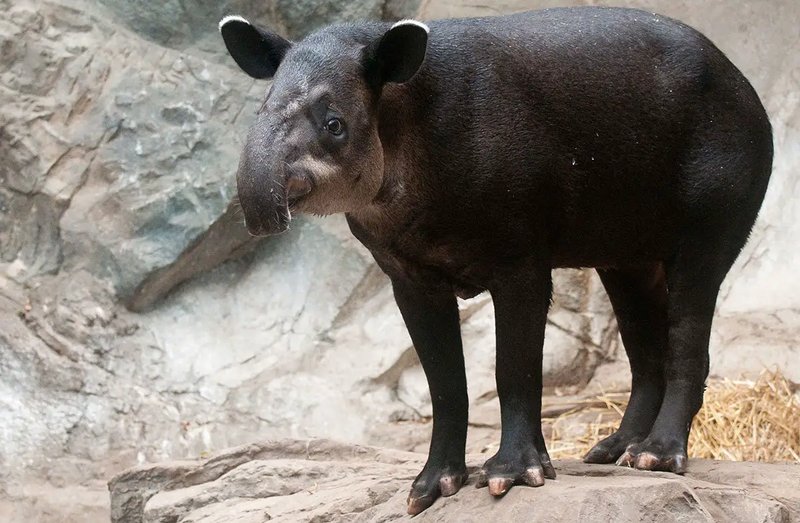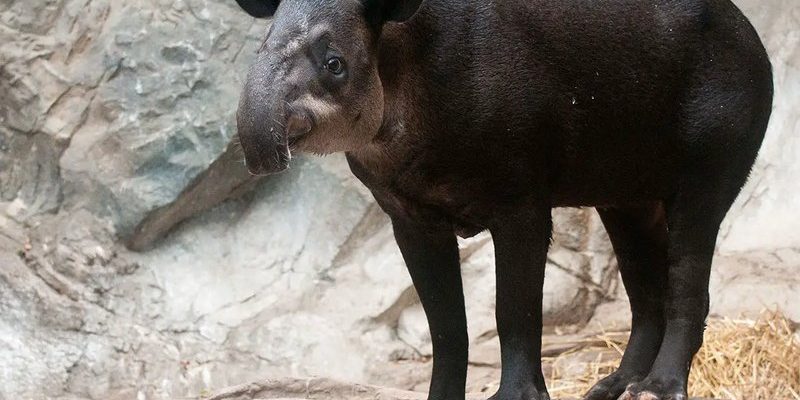
So, what about other animals that share similar traits with the Baird’s tapir? Let’s dive into the world of creatures that might remind you of this quirky mammal. Just like spotting a familiar face in a crowd, knowing how to tell them apart can be just as fun and informative. Whether you’re curious or just love animals, I’m here to break it all down for you, one step at a time.
Baird’s Tapir: An Overview
Before we go on a journey to meet its lookalikes, let’s get to know the Baird’s tapir a little better. This species is the largest of the tapirs, reaching up to 8 feet in length. They have a distinctively rounded body covered in thick skin, and their unique prehensile snouts help them forage for food like leaves and fruits in dense forests.
You might find it interesting that the Baird’s tapir is herbivorous and plays a crucial role in its habitat. By munching on fruits and vegetables, they help to spread seeds across the forest, which supports plant growth. If you’ve ever had a veggie-heavy meal that made you feel like a nurturing force—like you’re growing life—then you can appreciate how the Baird’s tapir contributes to its ecosystem.
1. Brazilian Tapir
Let’s start with the Brazilian tapir, or *Tapirus terrestris*. This cousin of the Baird’s tapir has a more robust body and can weigh between 440 to 660 pounds! Its dark brown fur can sometimes have a grayish tint, making it look a bit chunkier than the Baird’s tapir.
Here’s the thing: while both species have similar habitats, the Brazilian tapir is found in South America, specifically in the Amazon rainforest. If you ever see one, notice its long, rounded ears and how its face is a tad more elongated compared to the Baird’s tapir. It’s a subtle difference, but once you catch it, you won’t forget it.
2. Malayan Tapir
Next up is the Malayan tapir (*Tapirus indicus*), often recognized by its striking appearance. Unlike the Baird’s tapir, the Malayan tapir is mostly black with a white patch on its face, legs, and belly, making it look quite fancy, if I do say so!
You might be wondering about its habitat. The Malayan tapir calls the dense jungles of Southeast Asia home, which is a far cry from the Central American forests where the Baird’s tapir thrives. If you spot one, pay attention to its shape—it’s more barrel-like, with a shorter nose. The Malayan tapir offers a whole new color palette that helps it blend into its tropical surroundings, while still sharing that unique tapir body style.
3. Hippopotamus
Now, let’s take a big leap and look at the hippopotamus. Sure, they live in different environments, but both the hippo and Baird’s tapir share a stocky build and webbed feet. Both love water, but the hippo prefers rivers and lakes, while the tapir enjoys swamps and marshes.
However, the hippo’s size sets it apart dramatically. Adult hippos can weigh between 3,000 to 4,000 pounds! They have huge mouths, which they use to graze on grass. While both enjoy a dip in water, the hippo’s daily routine is more about grazing in the evenings rather than foraging among trees like the tapir.
4. Rhinoceros
Next, let’s talk rhinos. These magnificent creatures are also stocky and sturdy like the Baird’s tapir, though they carry their weight differently—much bulkier. While the Baird’s tapir might remind you of a short, stocky animal, rhinos have that iconic horn and larger overall mass.
Most importantly, there are different types of rhinos, like the white and black rhinos. Unlike the solitary Baird’s tapir, many rhinos are social animals, often found in small groups. If you spot a rhino, look for its thick skin, which is quite different from the tapir’s softer hide, but both have that prehistoric vibe that makes them fascinating to observe.
5. Pygmy Hippopotamus
You might be surprised to learn about the pygmy hippopotamus. It’s smaller than its larger relative, the hippopotamus, and has a shape and stance similar to the Baird’s tapir. While the pygmy hippo is more compact and has a more rounded body, its love for water makes it easy to compare.
These little guys live in the forests and swamps of West Africa, enjoying a diet of fruits and plants, similar to the tapir. Though they may not be as well-known, they share that same quirky charm—perfect for anyone who finds joy in animals that don’t quite fit the mold.
6. Capybara
How about the capybara? This giant rodent looks like a cross between a guinea pig and a tapir, sporting a similar stocky shape but on a smaller scale. Capybaras live in groups near water bodies in South America. They’re social creatures, often seen lounging together.
While both tapirs and capybaras have a herbivorous diet, the capybara’s lighter frame (weighing up to 150 pounds) and sociable nature set it apart from the more solitary Baird’s tapir. When you see a capybara, its playful demeanor might remind you of a friendly dog, while the tapir holds a more reserved presence.
7. Oncilla
The Oncilla, or little tiger cat, is another animal that’s quite different but has a few resemblances mainly in body shape. This small wild cat looks like a miniature leopard, and while it doesn’t share a habitat with tapirs, the way it prowls through the underbrush mirrors how a tapir navigates its dense environment.
Since Oncillas are much smaller and have a more agile body, it’s fascinating to think about how animals with such different diets and behaviors can inhabit similar ecosystems. Both play significant roles in their habitats, but their methods of survival are as different as night and day.
8. Aardvark
Last on our list, we have the aardvark. This nocturnal creature shares some physical traits with the Baird’s tapir, like its elongated snout and stout body. While the aardvark loves to dig through the ground for ants and termites, the tapir searches for foliage in trees.
Their habitats differ significantly—the aardvark is native to Africa, while the Baird’s tapir is found in Central America. Yet, you could draw comparisons about their unique features: both have a blend of traits that make them stand out in their respective environments.
So, there you have it! Ten fascinating animals that share traits with the Baird’s tapir, yet each is unique in its own right. Whether it’s the colorful Malayan tapir or the sociable capybara, every animal plays an important part in its ecosystem. Learning how to distinguish between these creatures is not just fun; it deepens our appreciation for wildlife and the diversity of life on Earth.
Next time you see a Baird’s tapir, you might think of these other animals and realize that similarities in the animal kingdom often come with surprising differences. Each creature tells a story, and understanding them can inspire you to protect their habitats and celebrate their uniqueness. Happy wildlife watching!

